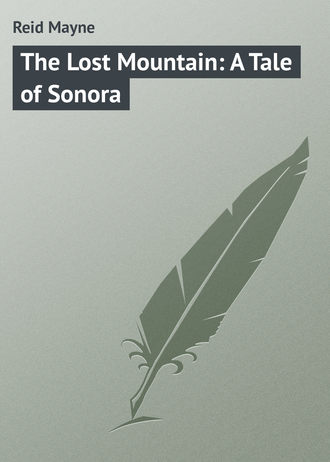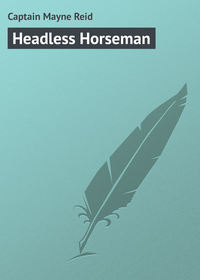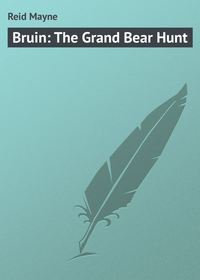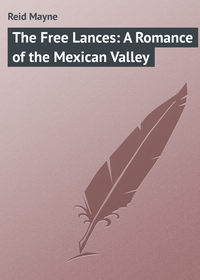 полная версия
полная версияThe Lost Mountain: A Tale of Sonora

Mayne Reid
The Lost Mountain: A Tale of Sonora
Chapter One.
In Want of Water
“Mira! El Cerro Perdido!” (See! The Lost Mountain!)
The man who thus exclaims is seated in a high-peak saddle, on the back of a small sinewy horse. Not alone, as may be deduced from his words; instead, in company with other men on horseback, quite a score of them. There are several wagons, too; large cumbrous vehicles, each with a team of eight mules attached. Other mules, pack animals, form an atajo or train, which extends in a long line rearward, and back beyond this a drove of cattle in charge of two or three drovers – these mounted, as a matter of course.
The place is in the middle of a vast plain, one of the llanos of Sonora, near the northern frontier of this sparsely inhabited state. And the men themselves, or most of them, are miners, as might be told by certain peculiarities of costume, further evinced by a paraphernalia of mining tools and machinery seen under the canvas tilts of the wagons. There are women seen there too, with children of both sexes and every age; for it is a complete mining establishment on the move from a veta, worn out and abandoned, to one late discovered and still unworked.
Save two of the party all are Mexicans though not of like race. Among them may be noted every shade of complexion, from the ruddy white of the Biscayan Spaniard to the copper-brown of the aboriginal, many being pure-blooded Opata Indians, one of the tribes called mansos (tamed). Distinctive points of dress also, both as to quality and cut, denote difference in rank and calling. There are miners pur sang– these in the majority; teamsters who drive the wagons; arrieros and mozos of the mule train; vaqueros with the cattle; and several others, male and female, whose garb and manner proclaim them household servants.
The man who has called out differs from all the rest in costume as in calling, for he is a gambusino, or professional gold-seeker. A successful one, too; since he it is who discovered the veta above spoken of, in the Great Sonora Desert, near the border-line of Arizona. “Denounced” it as well – that is, made declaration and registration of the discovery, which, by Mexican law, makes the mine his own, with exclusive right of working it. But he is not its owner now. Without sufficient means to undertake the exploitation, he has transferred his interest to those who can – Villanueva and Tresillian, a wealthy mining firm, long established near the town of Arispe, with all their employés and a complete apparatus for excavating, crushing, and amalgamating – furniture and household gods added – are en route for the new-found lode, with high hopes it may prove a “bonanza.” It is their caravan that is halted on the plain, for to halt it has come at a hail from the gambusino himself, acting as its guide.
He is some distance in advance of the wagons with two other horsemen, to whom his speech is particularly addressed. For they are the chiefs of the caravan – the masters and partners of the mining company composing it. One of them, somewhat over middle age, is Don Estevan Villanueva, a born Mexican, but with features of pure Spanish type, from his Andalusian ancestry. He is somewhat the senior of the two, and senior partner of the firm, the junior being Robert Tresillian, an Englishman, and native of Cornwall.
Up to that moment there had been anxiety on the countenances of both, as on those of their followers, indeed more, a look of gravest apprehension. Its cause is apparent; a glance along the line of animals – ridden horses as well as draught and pack-mules – clearly proclaiming it. All show signs of distress, by sides hollowed in, necks outstretched and drooping, eyes deep down in their sockets, and tongues protruding from lips that look hot and dry. No wonder! For three days they have not tasted water; and the scant herbage of the plains, on which they have been depasturing, is without a particle of moisture. It has been a season of drought all over Sonora, not a drop of rain having fallen for months, and every stream, spring, and pool along their route dried up. Little strange, then, the animals looking distressed, and no more that the minds of the men are filled with gloomy fears as to what might be before them. Another three days, and it may be death to most, if not all.
Just in like proportion are their spirits uplifted on hearing the exclamation of the gambusino. Well know they what it means – good grass and abundance of water. All along has he been telling them of this, picturing the “Lost Mountain,” or, rather, a spot by its base, as a very Paradise of a camping-place. No want of water there, he has said, however dry the season or long-continued the drought; no fear of animals being famished, since not only is there a spring and running stream, but a lake, surrounded by a belt of meadow-like land, with grass thick, succulent, and green as emeralds.
“You’re sure it’s the Cerro Perdido?”
It is Don Estevan who thus doubtingly interrogates, his eyes fixed on a solitary eminence seen afar over the plain.
“Si, señor,” affirms the guide, “sure as that my name’s Pedro Vicente. And I ought to be sure of that, from what my mother told me; the old lady in her life never getting over her anger at the cost of my christening. Twenty silver pesos, with a pair of church candles – big ones, and of best wax! All that for only handing down to me my father’s name, he being Pedro, and a poor gambusino as myself! Carramba! The padres are the veriest extortioners – levy black-mail more rigorously than either footpad or highwayman.”
“Vaya, hombre!” rejoins Don Estevan. “Don’t be so hard upon the poor priests. And as for the expense your mother was put to in celebrating your baptismal rites, that’s all past and gone. If you were poor once, you’re now rich enough to care nothing for such a trifle as twenty dollars and a couple of wax candles.”
The senior partner speaks truth, as any one who had seen Pedro Vicente three months before, seeing him now, would say. Then was he sparely clad, in garments of faded hue, tattered and dust-stained; his mount the scraggiest of mustangs – a very Rosinante. Now bestrides he a horse of best blood and shapely proportions, in a deep tree-saddle of stamped leather, with ornamental housings; his own body bedight with all the glittering adornments peculiar to that special Mexican dress known as “ranchero,” picturesque as any in the world. His lucky find of gold, still in its matrix of quartz —madre de oro, as the Mexican miners call it – with its transference to Villanueva y Tresillian, has given him sufficient of this same metal with the mint stamp on it for all matters of comfort, costume, and equipment.
“Oh! bother your christening and candles,” puts in the Englishman, with a show of impatience; “we’ve something more serious to think about. You’re quite sure, Señor Vicente, that yonder eminence is the Cerro Perdido?”
“I’ve said,” laconically and somewhat gruffly answers the guide, showing slightly nettled at the doubt cast on his affirmation, and by one he supposes a stranger to the country and its ways – in short, a “gringo.”
“Then,” pursues Tresillian, “the sooner we get to it the better. It’s ten miles off, I take it.”
“Twice ten, caballero, and a trifle over.”
“What! Twenty miles? I can’t believe that.”
“If your worship had been roaming about these llanos as long as I have, you could and would,” rejoins the guide, in quiet confidence.
“Oh! if you say so, it must be. You seem to know, Señor Vicente; and should, from all I’ve heard of your skill as a path-finder. That you’re good at finding gold we have the proofs.”
“Mil gracias, Don Roberto,” returns the gambusino, with a bow, his amour propre appeased by the complimentary speech; “I’ve no doubt about the distance, for I’m not trusting to guesswork. I’ve been over this ground before, and remember that big palmilla.” He points to a tree at some distance, with stout stem, and a bunch of bayonet-like leaves on its summit – a species of yucca, of which there are several straggled over the plain, but this one taller than any. Then adds, “If your worship doubts my word, ride up to it, and you’ll see a P and V carved in the bark, the initials of your humble servant. It was done to commemorate the occasion of my first setting eyes on the Cerro Perdido.”
“But I don’t doubt your word,” says Tresillian, smiling at the odd memento in such an out-of-the-way place; “certainly not.”
“Then, señor, let me assure you that from it to the mountain is all of twenty miles, and we’ll do well if we get there before sun-down.”
“In which case, the sooner we start for it the better.”
“Yes, Pedro,” adds Don Estevan, speaking to the gold-seeker in a friendly, familiar way. “Ride back and give the order for resuming route. Tell the teamsters and all to do their best.”
“At your worship’s command,” returns the gambusino, with a bow, and wave of his broad-brimmed hat raised high over his head.
Then, pricking his horse with a spur having rowels full five inches in diameter, he canters off towards the caravan.
Before reaching it he again uncovers, respectfully saluting a group which has not yet been introduced to the reader, though possibly the oddest, with the individuals comprising it, the most interesting of all the travelling party. For two of them are of the fair sex – ladies – one middle-aged and of matronly aspect, the other a girl late entered upon her teens. Only their faces and the upper portion of their forms are visible, for they are inside a sort of palanquin – the litera of Mexico, used by grand dames on long journeys, and roads over which carriages cannot be taken. The face of the older lady, with dark complexion and features of Andalusian type, is still attractive, but that of the younger one strikingly beautiful; and between the two is a strong family resemblance, as there should, since they are mother and child – the Señora Villanueva and her daughter.
The litera is borne between two mules, attached to shafts fore and aft, in charge of a strapping fellow in velveteen jacket, and calzoneras, botas of stamped leather, and sombrero of black glaze, with a band of silver bullion round it. But there is a fourth personage comprising the group, unlike all the others, and bearing no resemblance to any of the wayfarers save one – the Englishman. To him the youth – for young he is – shows the likeness, unmistakable, of son to father; and such is the relationship between them.
Henry Tresillian, just turned seventeen, is a handsome fellow, fair-haired, of bright complexion, and features delicately chiselled, still aught but effeminate in their expression; instead, of a cast which proclaims courage and resolution, while a figure tersely knit tells of strength and activity equal to anything. On horseback, he sits bending over in his saddle with face to the curtains of the litera. There may be eyes inside admiring him; and the expression of his own tells he would fain have it so. But all their eyes, late full of gloom, sparkle delightedly now. The Lost Mountain has been sighted; their fears are over, and so soon will be their sufferings.
“Anda! adalante!” (advance) shouts Pedro Vicente.
His words echoed rearward along the line, followed by other cries, with a creaking of wheels and a cracking of whips, as the wagons once more got into motion.
Chapter Two.
The “Coyoteros.”
The moving miners are not the only travellers making for the Cerro Perdido on this same day. Just as they have sighted it, approaching from the south, another party is advancing towards it from the north, though not yet within view of it, from being farther off, with a swell of the plain interposed.
Very different in appearance, and, indeed, almost in every respect, is this second band from that already introduced to the reader; in count of men outnumbering the latter by more than treble, though in bulk as a moving mass far inferior to it. For with it are no wagons, nor wheeled vehicles of any kind; no mule train nor cattle drove. Neither are they encumbered with women and children, least of all a litera and ladies. All men, and every one of them on horseback, each bearer of his own baggage, as well he may be, so little and light it is. Their sole impedimenta consist of a few trifling commodities, chiefly provision wallets, with water gourds (xuages) strapped over their shoulders or tied to the wither-locks of their horses. Equally unobstructive is their garb, few of them having other articles of dress than a breech-clout, leggings, and moccasins, with a rolled-up blanket or serape in reserve. The exceptions are some half-dozen, who appear to exercise authority, one especially holding command over all.
His insignia are peculiar; a coat of arms that would puzzle all the heraldic colleges of Christendom. Nor does he wear it on his shield, though one he carries. It is borne on his naked breast of bronze black, in a tattooing of vivid red; the device, a rattlesnake coiled and couchant, with tail and head erect, jaws wide agape, and forked tongue protruding ready to strike. Beneath are other symbols equally eloquent of anger and menace; one in white, set centrally, well known all over the world – the “death’s head and crossbones.”
It need hardly be said that he, embellished with this savage investiture, is an Indian, and his following the same. Indians they are, of a tribe noted for bloodthirstiness beyond all others of their race; for they are the Wolf-Apaches, or Coyoteros, so called because of mental and moral attributes which liken them to the coyoté– jackal of the Western world.
Unaccompanied by their women and children, as unencumbered with baggage, proclaims them on a warlike expedition – a maraud; their arms and equipments telling of the same. They carry guns, and long-shafted lances with pennons attached, that no doubt once waved above the heads of Mexican lanzeros. Pistols too, some even having revolvers, with rifles of latest pattern and patent; of which by their way of handling them they well know the use. If civilisation has taught them nothing else, it has how to kill.
They are marching along, not in ruck, or straggling crowd, but regular formation, aligned in rank and file, “by twos.” Long since have the Horse Indians of both prairie and pampa learnt the military tactics of their pale-faced foes – those special to cavalry – and practise them. But nowhere with more ability and success than in the northern states of Mexico – Tamaulipas, Chihuahua, and Sonora – where Comanches, Navajoes, and Apaches have charged in battle line, breaking that of their white adversaries, and scattering them as chaff. “Indian file,” oft used as a synonym for “single file,” is a march formation long since abandoned by these Transatlantic Centaurs, save where the nature of the ground makes it a necessity.
None such exists on the open llano, where this Apache band is now; and they might move in a column or extended line, if willing it; but numbering scant two hundred, they prefer the double file. Unlike the miners, in their three days’ traverse of a waterless desert, they have been making way through a district with which they are familiar; acquainted with all the camping-places – every stream, spring, and pond – so they have not suffered from want of water. Nor are they likely now, since their course lies along the banks of a creek – a tiny rivulet, yet running, despite the continued drought. It is a branch of the Rio San Miguel of the maps – locally known as the Horcasitas – and they are descending it southward, thirst having no terrors for them.
Just as the sun is about to set they catch sight of the Cerro Perdido. To them it is not known by that name, but Nauchampa-tepetl. Somewhat strange this, pointing to an affinity known to exist between the Indians of Northern Mexico and the Aztecans of the South. In the language of these last the mountain Peroté bears the same designation, the “Cofré” usually attached being synonymous with “Nauchampa,” both signifying chest, or box. For the Cerro Perdido, viewed from certain points, bears a quaint resemblance to this, as does also the summit of Peroté.
Neither philology nor ethnography is in the minds of this band of redskins; their thoughts are dwelling on a subject altogether different – robbery and murder. For they are on the maraud; their objective point the towns on the Horcasitas.
Just now, however, as they sight the Cerro, another question occupies them: whether it be prudent or possible to continue on to it without halting for the night. Some say Yes, but most No. It is still good twenty miles off, though appearing scarce ten. In the diaphanous atmosphere of the Sonora tableland distances are deceptive, as Pedro Vicente has said. But the native inhabitants, above all the aborigines, are aware of this, and reckon accordingly. Besides, the Coyoteros, like the gambusino, have been over the ground before, and are familiar with every foot of it. So distance has nought to do with their discussion, save as it affects the capability of their horses. Since morning they have made fifty miles, and are fagged; twenty more would be killing work for them. And the twenty to Nauchampa-tepetl will be a nice distance to their next day’s noon halt.
The question of continuing on is at length decided in the negative, by him of the grotesque heraldry dropping down from his horse, and proceeding to picket the animal on the grass. As his example has the force of a command, all the others follow it, and camp is quickly formed. A simple affair this; only the tethering out of their steeds, and stripping them of such caparison as they carry. Then follows a search for dry faggots, and the kindling of a fire; not for warmth, but cooking. There is a bit of butchering to precede; these redskinned rovers having their commissariat on the hoof – this in the shape of some spare horses driven along en caballada. A knife drawn across the throat of one lets his blood out in a torrent, and he drops down dead, – to be skinned and cut up in a trice, the pieces impaled upon sticks and held over the blaze of the fire.
But the hippophagists avail themselves of other comestibles of a vegetable kind; seeds from the cones of the piñon, or edible pine, and beans of the algarobia– trees of both sorts growing near. Enough of both are collected and roasted, to form an accompaniment to the horseflesh.
Fruit they find too on several species of cactus; the best of them on the pitahaya, whose tall rigid stems, with limbs like the branches of a candelabrum, tower up around their camp. So, in the desert – for it is such – they are enabled to end their dinner with dessert. To provide something for breakfast besides, a viand rare and strange, but familiar to them, a branch of their tribe – the “Mezcaleros” – making it their staple food, even to deriving their tribal appellation from it. For it is the mezcal plant, one of the wild species of magueys (Agave Mexicana). The central core, from which radiate the stiff spinous blades, is the part eaten, and the mode of preparing it is now made manifest in the Coyotero camp. Several plants are torn out by the roots, their leaves hacked off, and the skin of the core itself cut away – leaving an egg-shaped mass of white vegetable substance, large as a man’s head, or a monster mangold-wurzel. Meanwhile, a hole has been “crowed” in the ground, pit-shaped, its sides fended by flat stones, with a like pavement at the bottom. Into this red coals are flung, nigh enough to fill it; an interval allowed for these to smoulder into ashes, and the stones become burning hot. The mezcals, already wrapped up in the horse’s skin late stripped off, red side inward, along with some loose pieces of the flesh, and the bundle is lowered down into the improvised oven, then all covered over with a coat of turf. Thus buried it is left to bake all night, and in the morning will afford them a meal Lucullus need not have disdained to partake of.
The Coyoteros, well sure of this, go to sleep contentedly and without care; each rolled-up in his own wrap, his couch the naked earth, canopied by a star-bespangled sky.
In that uninhabited and pathless wilderness, or with paths only known to themselves, they have little fear of encountering an enemy; and as little dream they that within less than two hours’ gallop of their camping-ground is another camp occupied by the foes of their race, too few to resist their attack. Knew they but this, there would be a quick uprising among them, a hasty springing to horse, and hurried ride towards Nauchampa-tepetl.
Chapter Three.
A Rush for Water
Meanwhile, with many a crack of whip and cry of “Anda!” “Mula maldita!” the miners have been toiling on towards the Lost Mountain. At slow pace, a crawl; for their animals, jaded and distressed by the long-endured thirst, have barely strength enough left to drag the wagons after them. Even the pack-mules totter under their loaded alparejas.
Viewing the eminence from the place where they had pulled up, the mine labourers, like the Englishman, had been inclined to doubt the guide’s allegation as to the distance. Men whose lives are for the most part spent underground, are as sailors ashore when above it, oddly ignorant of things on the surface, save what may be learnt inside a liquor saloon. Hence their unbelief in Vicente’s statement was altogether natural. But the mule and cattle-drivers knew better, and that the gambusino was not deceiving them.
All come to this conclusion ere long, a single hour sufficing to convince them of their mistake; at the end of which, though moving continuously on, and making the best speed in their power, the mountain seems far off as ever. And when a second hour has elapsed, the diminution of distance is barely perceptible.
The sun is low down – almost touching the horizon – as they get near enough to the Cerro to note its peculiar features; for peculiar these are. Of oblong form it is; and, viewed sideways, bears resemblance to a gigantic catafalque or coffin, its top level as the lid. Not smooth, however, the horizontal line being broken by trees and bushes that stand in shaggy silhouette against the blue background of sky. At all points it presents a façade grim and precipitous, here and there enamelled by spots and streaks of verdure, wherever ledge or crevice gives plants of the scandent kind an opportunity to strike root. It is about a mile in length, trending nearly north and south, having a breadth of about half this; and in height some five hundred feet. Not much for a mountain, but enough to make it a conspicuous object, visible at a great distance off over that smooth expanse of plain. All the more from its standing solitary and alone; no other eminence within view of it, neither sierra nor spur; so looking as if strayed and lost– hence the quaint appellation it bears.
“At which end is the lake, Señor Vicente?” asks the elder Tresillian, as they are wending their way towards it; he, with Don Estevan and the guide, as before, being in advance of the wagon train.
“The southern and nearer one, your worship. And luckily for us it is so. If it were at the other end, we’d still have a traverse of a league at least before reaching it.”
“How’s that? I’ve heard that the Cerro is only a mile in length.”
“True, señor, that’s all. But there are rocks strewn over the llano below, for hundreds of yards out, and so thick we couldn’t take the wagons through them. I suppose they must have fallen from the cliffs, but how they got scattered so far, that puzzles me, though rocks have been the study of my life.”
“So they have, Pedro,” put in Don Estevan. “And you’ve studied them to some purpose. But let us not enter into a geological discussion now. I feel more concerned about something else.”
“About what, your worship?”











